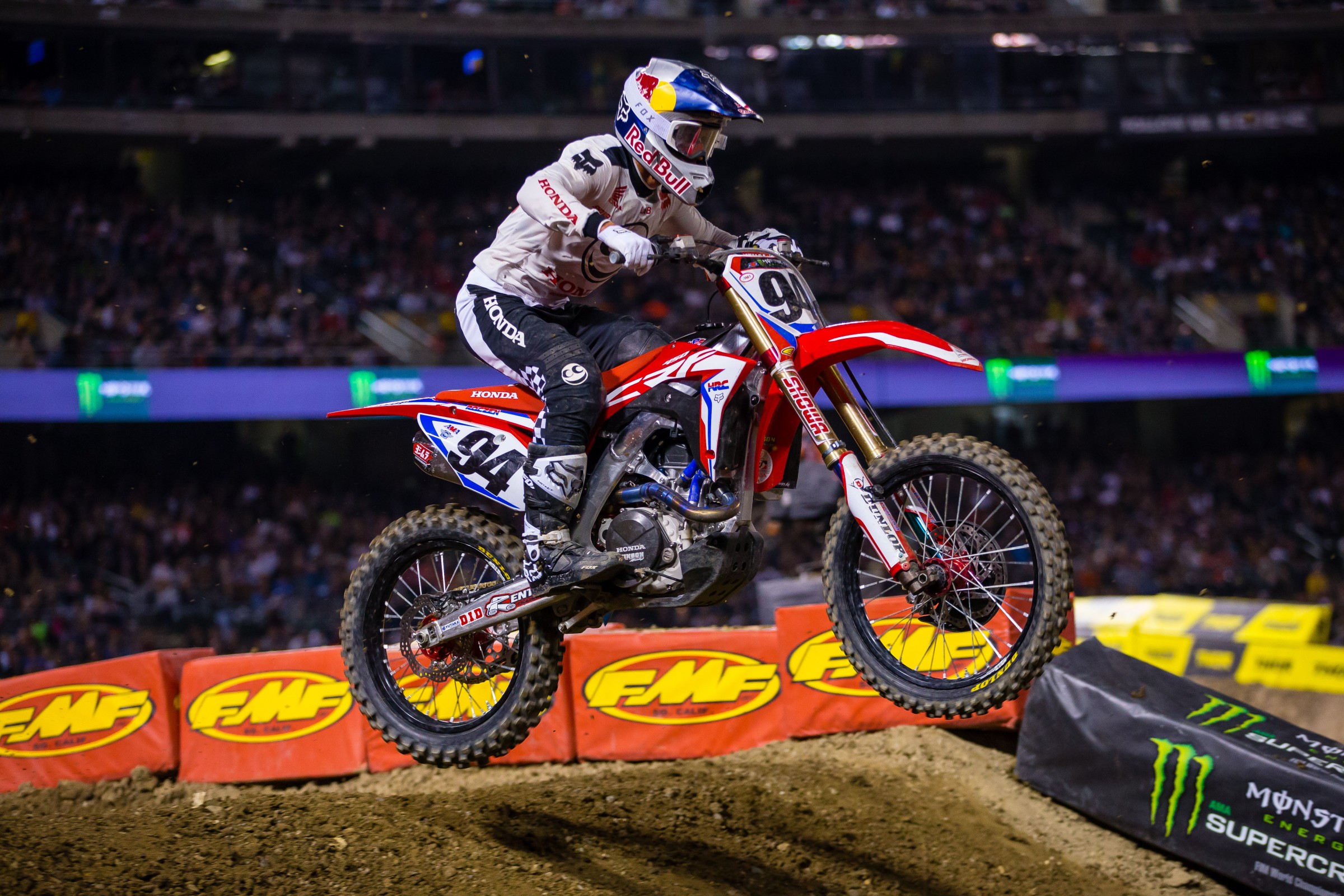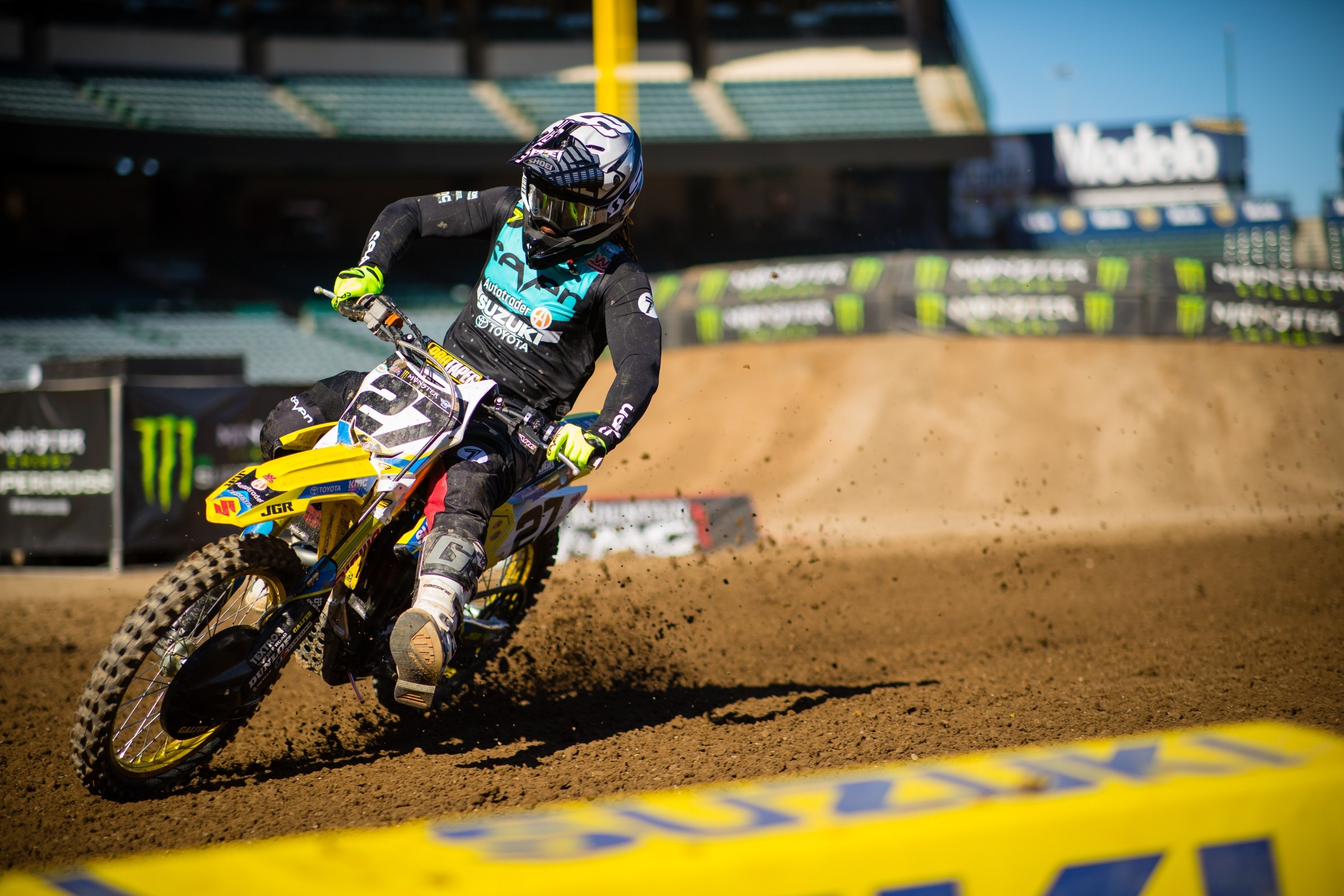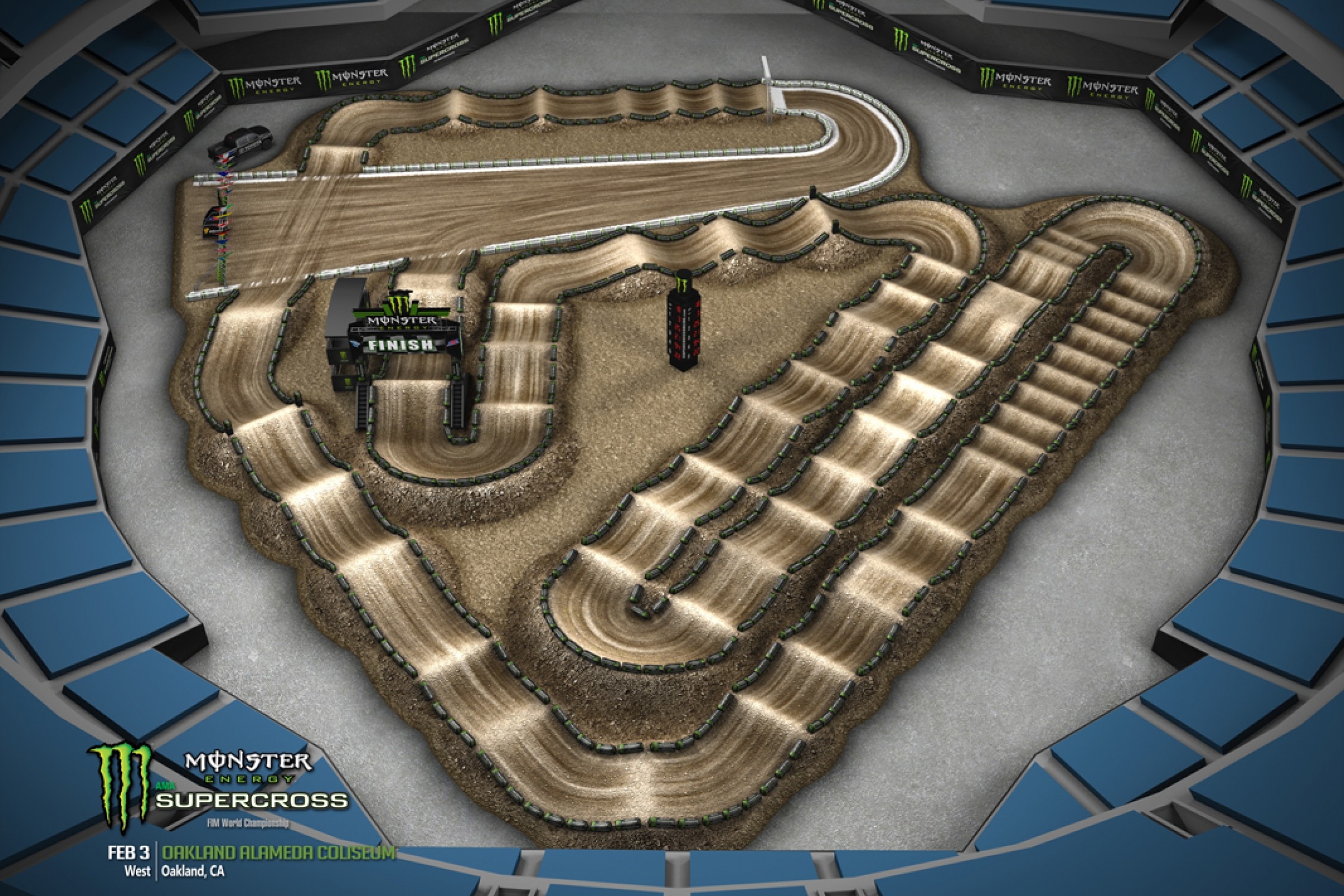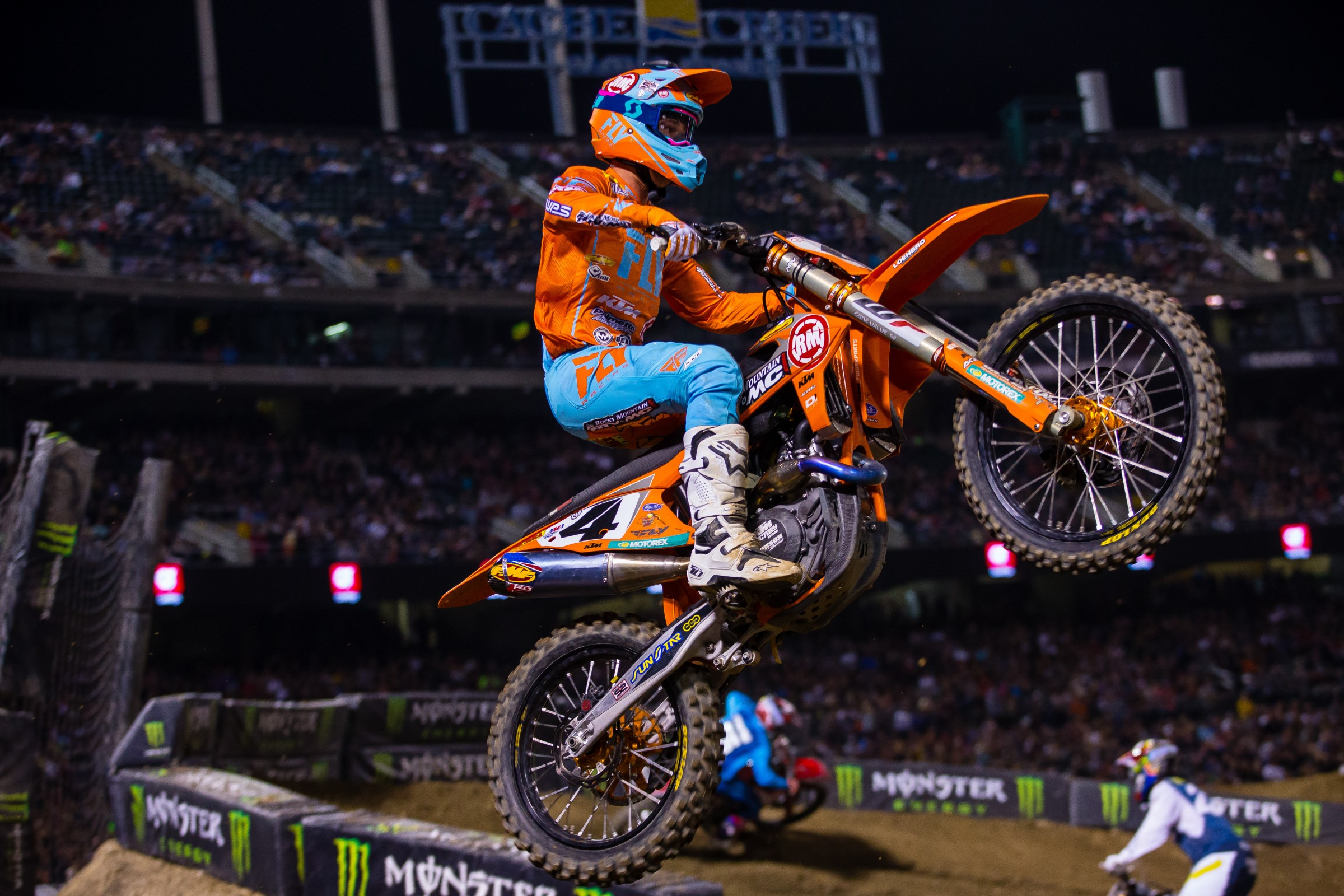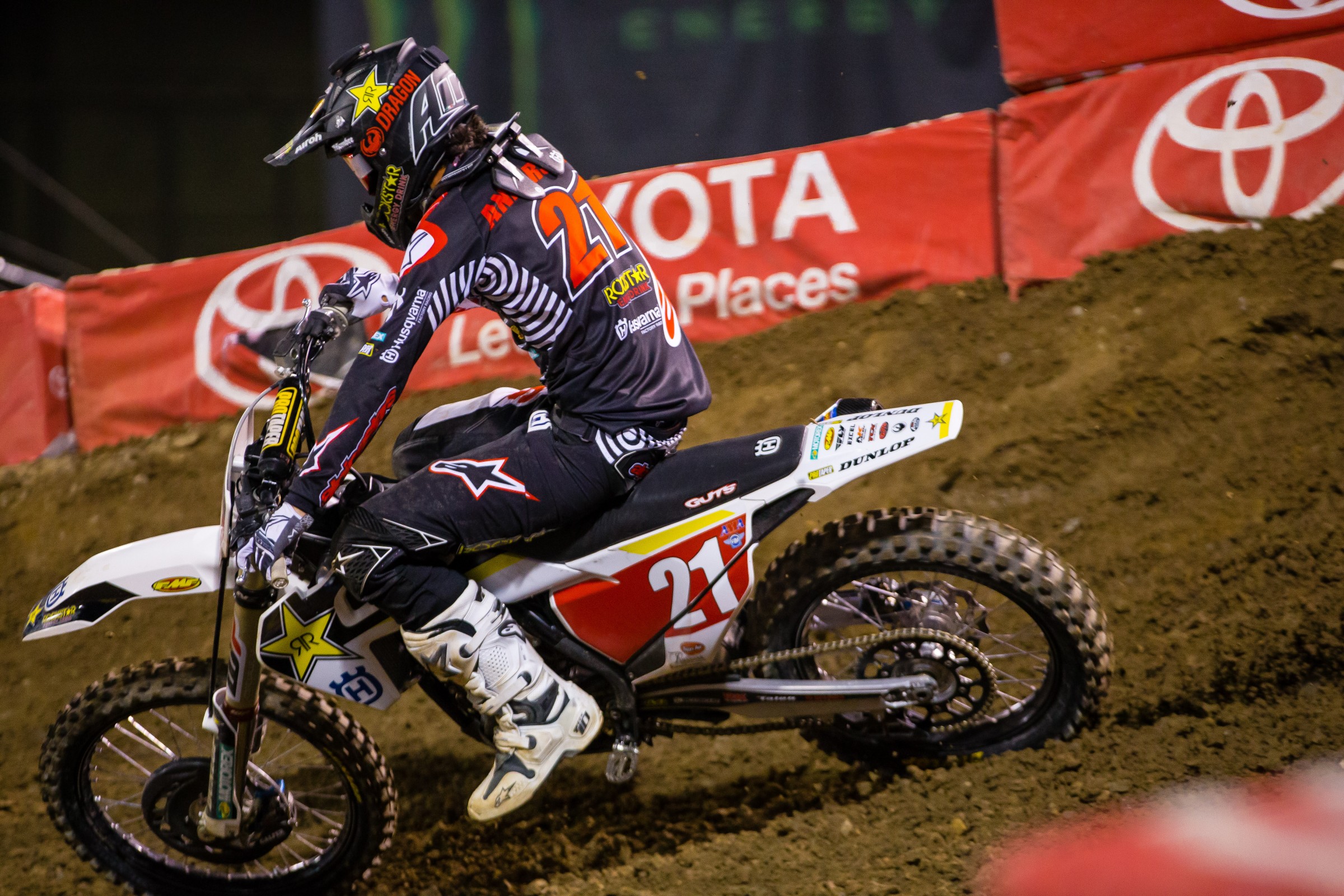The 450SX main event at round five of Monster Energy Supercross was an all-time classic, with tons of passes, crashes, and action all leading to a fantastic Jason Anderson/Ken Roczen duel for the lead that wasn't decided until the final half-lap. Oakland's dirt got soft and rutted, and the broken-down track led created mistakes everywhere and made the racing incredible.
Behind them, Blake Baggett capitalized on a good start and stayed close to Anderson until lapped traffic got crazy, but he held on for his first podium of the year on his Rocky Mountain ATV/MC WPS KTM. Up front, Roczen (Honda HRC) lost the lead, retook it from Anderson, but then bobbled on the last lap, allowing Anderson (Rockstar Energy Drink Husqvarna) to shoot back past him to take the lead and the win.
All three riders joined the media in the post-race press conference.
Racer X: Blake, congratulations. I think it’s been pretty clear through four rounds the riding has been pretty good, but the results haven’t really matched. What was it about tonight that helped you put everything together?
Blake Baggett: I would say it’s just the start and track position right away is really key nowadays. It seems like the racing’s getting tight. Everybody’s getting so close that if you’re not there right off the bat and within that first five, six guys you can’t make it happen. So, I got off to a good start and was able to just hang the wheel with the front pack and then kind of get into a groove.
Ken, congratulations. Walk us through those last three laps when you were balancing focusing on the track and also being in the middle of a battle.
Ken Roczen: It was a great, fun race. I grabbed a good start and tucked right in there behind Cole. Cole was going really good. Did a mistake in front of me and then I was leading. I knew that I was just not trying to get too amped up and try to push even more, just because I knew the track was going to get worse and worse. Especially in those tight rhythm sections, it’s easy to rush. You clip something or actually jump a little bit too far and you land in the ruts and then have to miss the next one or possibly go down. When the ruts were there, like in the heat race, you hit a hard spot and it’s fine, but I was pretty surprised how soft it was again after they fixed it before the main event. It got really soft. It didn’t hold up too long. There were definitely a few close calls out there with lappers. Myself, I actually rode pretty clean, but towards the end, the last couple of laps were something. Jason got by me somehow. I don’t even remember, to be honest. We had a good battle. I was really bummed just because we worked so hard on a difficult track like that just to pretty much give it away on the last half a lap, or last quarter of the lap. All in all, we’re healthy and in the championship hunt and we’re moving forward. So, overall a good night.
Jason, congratulations. We know you had the crash earlier today in qualifying. How were you feeling in those later stages of the main event? Were you feeling that at all, or were you able to kind of let the adrenaline take over?
Jason Anderson: Yeah, at the beginning of the day, the first free practice, I endoed so hard over that thing. I honestly got away from the bike pretty good. I belly-flopped down the backside, but my bike just hit me in the back. All day my back was a little sore. Honestly, it kind of scared me. The worst thing that could happen to you on the track happened to me in the first couple laps. So, I was very hesitant all day. Even in that heat race, I was not that good. I was literally a fifth-place guy in that heat race. I really had to bring it around. That battle at the end of the race was crazy. We were both making mistakes. The track was so hard to just hit your marks. The lappers kind of played a factor because you were used to one line the whole main, and whenever you get behind them you have to switch it up, [and] you don’t know how deep the holes are. It was insane, but it felt great. It’s awesome.
This question is for Jason, and Ken, you can touch on it as well. How essential was it that you guys had basically a clean track to ride on for the last three laps or so? There was a big gap in the lappers. Was that pretty essential for you guys to go toe-to-toe and kind of feel comfortable out there?
Anderson: Yeah. The last two laps or so were kind of a blur for me. If I think about it, we were back and forth and side by side so many times those last three laps. Any time you felt like you got out front, we both made a mistake. I made a mistake in the one rhythm section and let him get on the inside of me. Then he made a couple mistakes and let me by. Luckily it was clear. It was pretty clear for the last few laps. We went toe-to-toe and it was insane.
Roczen: Yeah, same. It was really just a blur. I think we’re so focused. That’s why half the race, you don’t remember. There were so many things happening that it’s hard to even remember how many and what exactly happened until you watch the race. I think what was scary for me once was I got together almost with Friese in the rhythm, and when you don’t jump and you also get cross-rutted—and I don’t know how far he was behind me, or really close, and have him possibly jump the triple when I don’t and I shoot to the right and whatnot and then land on me or whatever. All those things matter. It got sketchy and kind of dangerous out there for a quick minute, but that’s just part of the track and part of racing.
Ken, I want you to talk a little bit more about the lappers. I noticed sometimes you got really out of your rhythm. How do you recover from that on a track like tonight?
Roczen: There were definitely a couple lappers that played a pretty big role. One of them that probably frustrated me the most was Josh Grant. He just unfortunately didn’t get out of the way, and that cost me pretty good. I think it’s more… what the most annoying part is you’re leading and you’re supposed to have a clear track and then you just get roosted for half a lap pretty bad. Again, that’s part of racing and it didn’t just happen to me. It happens to everybody. Sometimes it plays more into this person’s favor, and sometimes it hurts the other one. It’s just tough. Like Jason said, you move out of your comfort line and you don’t know how much it kicks or how deep it is or what’s going on there. So that was actually really the tough part. Then do you threaten the needle and just send it and jump it, or do you just cruise and double it and it could cost so much time? It’s difficult because you have to make that decision in just a split second.
Blake, you capitalized on a great start, but also the fact that you rode pretty clean the entire moto. What was the most challenging part for you throughout the moto?
Baggett: I felt good until we got to the lappers. I was just pacing myself off of Jason. I was right behind. We were in a freight train. I could tell that we were kind of moving forward on where Kenny was. I was kind of spotting it and I knew the lappers were coming into play. Like they say, as soon as we got to Vince Friese, he just didn’t see the blue flag I guess for like four laps in a row and it cost me big. But I think everybody in the whole field that’s raced has had those problems. Everybody has to do it. You get used to that one line, that one six inches of track. It’s no big deal to switch it up when it’s hard-packed and paved like the freeway, [but] when you’ve got ruts all the way across and some of them are two feet deep and you’ve never even been in it, it gets uncomfortable and you’re not sure whether to pull the trigger or not because you’re not sure if you want to pay the consequences.
They never fixed the face of where you guys were going triple onto the table right after that corner there. Did that really start to break down? How did you guys handle that?
Baggett: The whole track broke down! If you go walk it right now, it’s insane. The bikes these days are so fast and have so much torque that from our sight lap to the last lap, I felt like it was three practices later and there had been 60 guys on the track. It’s ever-changing and it was super soft in the pockets. It seemed like it was softer in the pockets in the main event than even in practice or the heat race for some reason. I don’t know if the moisture was coming up or what, but the pockets were really soft.
Anderson: That three-on right there, for me, honestly, I was making up a lot of time right there, going three-on. But the times where I came out of the corner and I was maybe not really set up for it, I lost time because I was still trying to go for it. I would kind of be a little front-end high because I wasn’t going to make it. But I hung the wheel up on that thing a couple times. It was kind of beat down from people casing it, so luckily if I’d have done that in practice it would have hurt a lot more.
Roczen: I didn’t know these guys were still jumping it! You had to go to the pretty far outside to make that, I feel like, and it started getting worse and worse and hitting Tuff Blocks. It kind of just deteriorated right there. I just kind of stuck to the inside there, even though I knew that tripling on there was definitely the faster way to go. Obviously, I kind of just stuck to the inside there. Like I said, I lost time there, so I’ve got to watch the tape and just learn from that.
Ken and Jason, I think that last lap where you guys went side-by-side over the finish line, I can’t remember the last time that happened in a main event. For you both, did you know where you could maybe make your pass or make a move stick? Or was it just go wide open and see what happened on that last lap? It could really happen either way.
Roczen: Once you got to the triple past the mechanics’ area, it could really happen anywhere there because there was so much going on in such a short part of the track, that we went back and forth a couple times. Then I made that mistake there and he got by. Then that next rhythm section, he could have clipped something. I could have jumped it and would have been right back to the inside there. Honestly, that last lap, it’s kind of a gamble a little bit. You can be leading like me, and normally on a track that’s not as broke down, you don’t make a whole lot of mistakes, then you’ve pretty much got it in the bag. But on a track like this, anything can happen, as you can see.
Anderson: After that triple, the whole rest of the track was honestly so out of control that you could have made a pass anywhere. I tripled on behind him and I got next to him in the whoops, but there was one good line in the whoops and I tried to go a little bit right. I almost went down the last lap in the whoops. I went into the corner and I was like, whoever hit that section the best was going to win. That last on-off, three, three and then the next section. That determined tonight’s winner. That last lap, whenever you’re trying to squeeze tight and make sure you get that line, is pretty tough and that whole part of the track. Honestly, tonight you couldn’t really plan your passes. It was just crazy.
For all three of you guys, is this going to be a main that you re-watch once, or is it going to be something that you watch over and over again?
Roczen: I don’t know if I want to watch it!
Anderson: Yeah, I think it depends. If you win, you want to watch it. If you don’t win, you’re just like, I don’t want to watch it. I’ve been on the other side too.
Baggett: I’m just going to delete it off my DVR!
Roczen: The tough thing, it’s really tough to learn something. I think if anything you can look at the bike and see what it did and if it gets deep or whatever. It’s different every lap, so it’s not like you can really learn a whole lot from it. In the end, it’s how much risk do you want to take and whether it goes good or not.
Congratulations to all three of you guys. You’ve already addressed the lapper situation. With the red cross flag coming out so late in the race, did that interfere with anybody’s flow or momentum?
Anderson: I have had my share of red flag getting docked and stuff like that. I was behind Kenny and I did exactly what he did.
Roczen: The red cross flag can be three jumps ahead. What do you do? In the end you can jump until you’re there, or do you roll all the way through? I still don’t know. I just roll.
Anderson: Even the lights, too, they say you can jump on a yellow light but not a red light, but when you’re in a rut, you don’t see the lights on the side of the track. If there’s a significant dude out there with a cross flag, obviously, you roll. But whenever you see the lights, it’s so hard to see yellow or red. It’s confusing.
Baggett: It’s a very vague, gray area.


